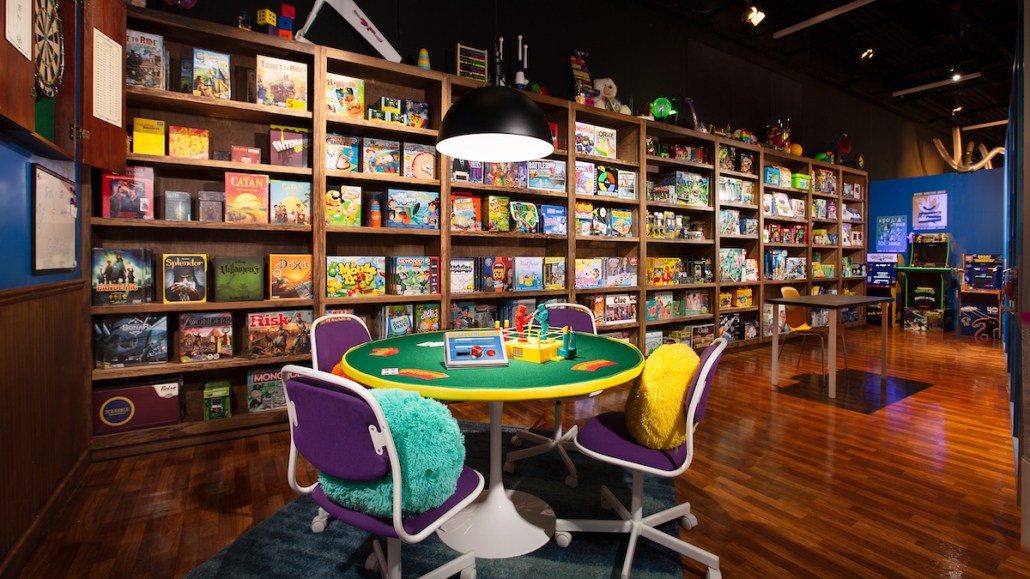‘A retail media company’: How CAMP wants its online content to eventually drive customers back to stores

CAMP was built to be a kid’s paradise — think toy store meets indoor activity hub. But like other in-person concepts, that came to a screeching halt last year and the family-focused retailer had to shift its strategy into one that now more directly resembles a digital publisher with a penchant for e-commerce.
That makes sense when you consider its CEO — Ben Kaufman, previously the chief commerce officer and chief marketing officer at BuzzFeed behind the brand’s buzzy forays into retail that further wooed over millennials.
But CAMP, founded in 2018, was going to be different venture as it was created with a brick-and-mortar-first strategy — a “conscious choice because we felt like that was the harder thing to do,” Kaufman said.
By the end of 2019, the toy store company had five locations between New York, Connecticut and Texas that collectively saw an average of 50,000 visitors per month. The company had pre-pandemic plans to build five to 10 more, but Covid-19 proved to be a mass blow for a retail store chain built on the premise of offering a space for children to play in-person around purchasable toys.
Despite that, CAMP’s overall revenue increased by 300% in 2020 compared to 2019, though exact revenue figures were not provided, and plans to open new locations will resume this year.
Ticket sales, in-store events and toy sales, were the primary sources of revenue in 2019, however, only 20% of the company’s revenue came from the actual sales of toys, according to a report by Digiday’s sibling site Modern Retail. And pre-pandemic, Kaufman said he classified CAMP as a consumer-facing business. In 2020, however, that shifted to a more B2B model that championed digital sponsorship deals with brands like Walmart (which partnered on a virtual summer camp) as well as Apple and Ally Financial — both of which sponsored a series of virtual birthday parties.
At the end of November, Kaufman said the company finally invested in creating a new, editorial-driven identity by building out an editorial arm led by editor-in-chief Tanner Greenring, who previously spent 11 years at BuzzFeed holding several different senior editorial and strategic positions. His team is now developing a more robust online presence that includes the shop as well as a virtual events business.
Because of this, Kaufman said that the company’s revenues are starting to revert back to being a customer-first company. And its a digital game plan Kaufman, and others, expected for the company, but one that was accelerated by the pandemic.
The new look of its digital operation mimics the quirky playfulness of the in-person stores. And it boasts products its selling as well as other fun-filled activities. While the Shop tab on the CAMP homepage is a pretty standard marketplace selling everything from an action figure of Vice President Kamala Harris to a handheld Oregon Trail game, the website is populated with content around art, cooking and other activities that don’t necessarily link back to any purchasable products.
“We call ourselves a retail media company because we do deliver media, and that media drives loyalty and that loyalty at times drives transactions,” Kaufman said. The main purpose of the site, however, is for families to answer the question: What should we do today?
E-commerce is projected to be about half of CAMP’s business in 2021, Kaufman said. Ultimately, the digital operation will evolve to be used as a brand marketing tool to attract customers into stores once the pandemic is over.
“The level of digital stuff we’ve done is amazing, but we do think that the brick-and-mortar and the experiential is going to come back in a very big way, post-pandemic,” said Kaufman. “We’re using this time and the digital work to really build the brand awareness and build the excitement for CAMP.”
The site is reaching more people beyond the three states with retail stores, but serves as an experiment to make the e-commerce experience more engaging than other online shopping experiences in the the crowded marketplace.
“E-commerce is very isolating and pretty boring; you search for something and you buy it,” said Kaufman.
As an example, ahead of the holidays, CAMP launched a virtual White Elephant Gift Exchange where family or friend groups could log on and buy gifts that were then virtually gifted, unwrapped and swapped. Once the party was over, CAMP took care of fulfilling the orders and sending them to the respective recipients. Kaufman said that within the first 10 days of launching the program, 25,000 people participated.
Because of this success, CAMP will create new online shopping experiences for birthday parties, baby showers and holidays like Valentine’s Day.
The approach of using an online presence as a marketing tool to grow store attendance is not one that many brands are doing, said Ben Zettler, a digital marketing and e-commerce consultant and founder of Ben Zettler Digital Media.
“This is likely a necessary step in order for them to survive, like any other toy company, but it’s an interesting approach to help balance the experience for former customers as well as a way to funnel customers into their actual store fronts,” Zettler said.
More in Media

Digiday+ Research: Publishers’ growing focus on video doesn’t translate to social platforms
Major publishers have made recent investments in vertical video, but that shift is not carrying over to social media platforms.

Technology x humanity: A conversation with Dayforce’s Amy Capellanti-Wolf
Capellanti-Wolf shared insight on everything from navigating AI adoption and combating burnout to rethinking talent strategies.

How The Arena Group is rewriting its commercial playbook for the zero-click era
The company is testing AI-powered content recommendation models to keep readers moving through its network of sites and, in doing so, bump up revenue per session – its core performance metric.








